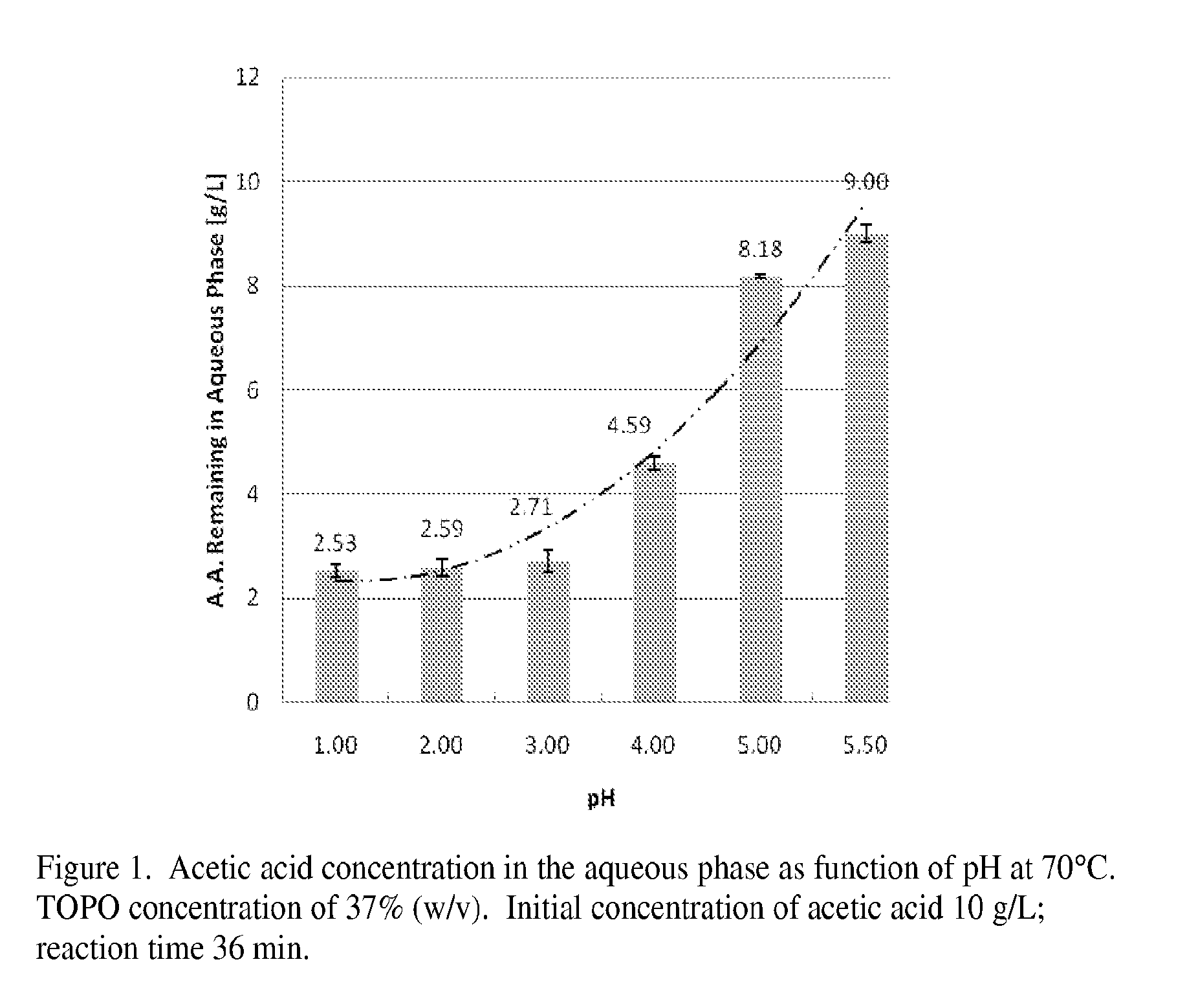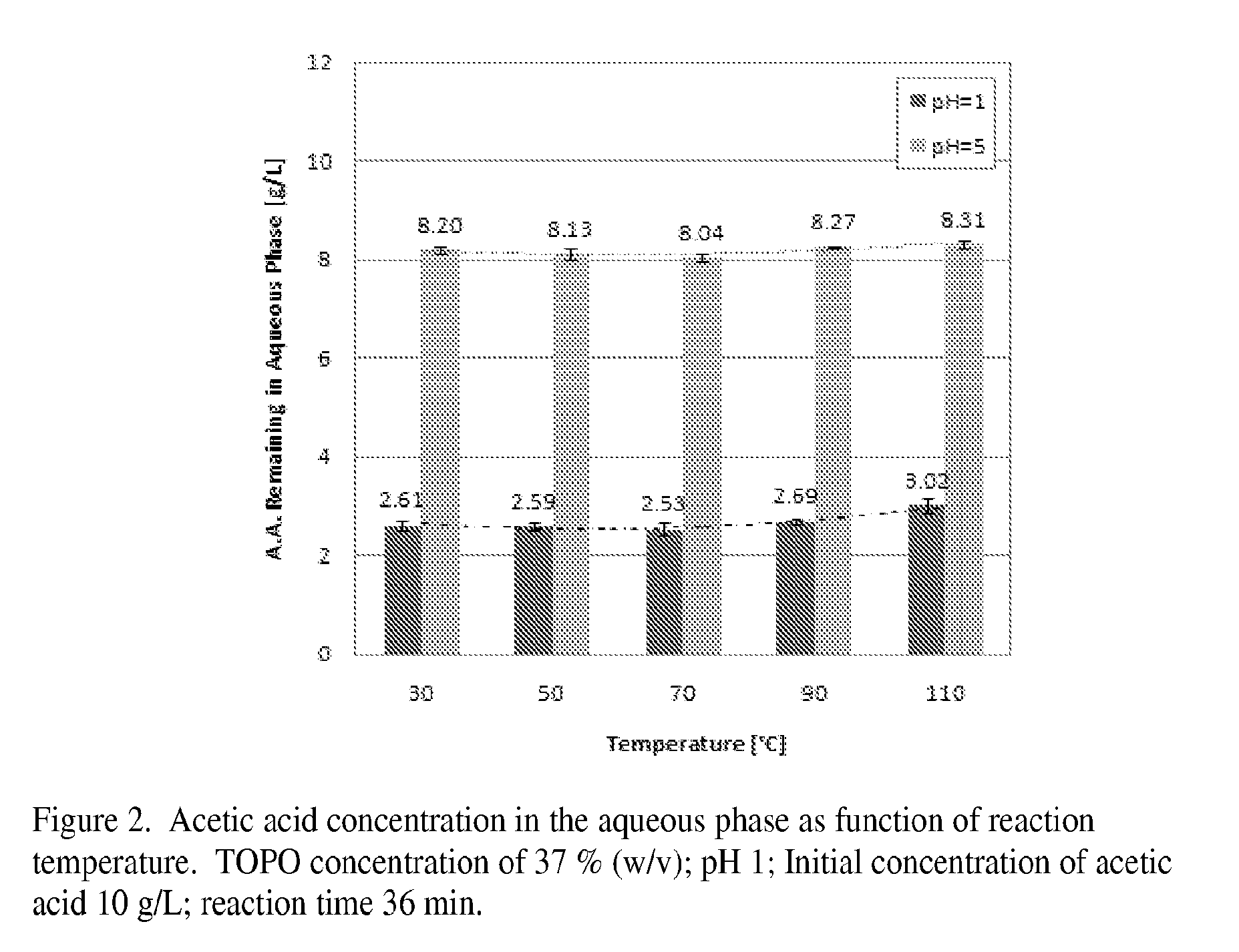Recovery of acetic acid from wood extracts
a technology of acetic acid and wood extract, which is applied in the preparation of carboxylic compounds, carboxylic acid halides, organic chemistry, etc., can solve the problems of unsuitable recovery of acetic acid from wood extracts by a process similar to the lenzing process
- Summary
- Abstract
- Description
- Claims
- Application Information
AI Technical Summary
Benefits of technology
Problems solved by technology
Method used
Image
Examples
example 1
[0019]In the experiments described below it is shown that TOPO-undecane is an efficient organic solution to remove acetic acid from sugar solutions obtained by treatment of wood with pure water or green liquor (aqueous solution of mostly Na2CO3). The results are compared with, and the optimum operating conditions for the extraction process are determined for acetic acid extraction from a pure acetic acid solution.
[0020]Materials and Methods
[0021]Green Liquor
[0022]Green liquor is the liquid obtained after dissolution of the liquid smelt obtained from the bottom of the kraft recovery boiler. It consists mainly of an aqueous solution of Na2CO3, Na2S, Na2SO4 and smaller quantities of other alkali metal salts. In this study, pure chemicals (Na2S: Sodium Sulfide hydrate, 65% extra pure, Na2CO3: Sodium carbonate monohydrate 99.5% extra pure, Fisher, Na2SO4: Sodium sulfate anhydrous, 99.2% extra pure, NaOH: Sodium hydroxide pellets, 98.5% extra pure, Pittsburgh, Pa.) were used for this stud...
example 2
[0042]A solution was prepared containing 10 g / l acetic acid, 10 g / l glucuronic acid (Sigma Aldrich; CAS number 6556-12-3; product number G5269-10G), 5 g / l glucose, 20 g / l xylose and 0.3 g / l furfural. This is called solution A and is representative of a wood extract. Solution B was prepared containing 10 g / l acetic acid and 0.3 g / l furfural. This solution is representative of an evaporator condensate when concentrating an acidified wood extract or acid sulfite pulping liquor. The pH of both solutions was adjusted to 2 using sulfuric acid.
[0043]5 ml of the solutions were pipetted into 10 ml reaction vessels, heated to 70° C. and mixed with 5 ml of TOPO / n-undecane (1 / 2). A batch extraction was performed by vigorously shaking the vessels for 7 seconds, followed by several minutes in a thermostat bath of 70° C. The shaking / thermostating was repeated six times.
[0044]After the extraction, the phases were separated by centrifugation and the remaining aqueous phase was analyzed. The results ...
PUM
| Property | Measurement | Unit |
|---|---|---|
| boiling point | aaaaa | aaaaa |
| weight | aaaaa | aaaaa |
| flow rate | aaaaa | aaaaa |
Abstract
Description
Claims
Application Information
 Login to View More
Login to View More - R&D
- Intellectual Property
- Life Sciences
- Materials
- Tech Scout
- Unparalleled Data Quality
- Higher Quality Content
- 60% Fewer Hallucinations
Browse by: Latest US Patents, China's latest patents, Technical Efficacy Thesaurus, Application Domain, Technology Topic, Popular Technical Reports.
© 2025 PatSnap. All rights reserved.Legal|Privacy policy|Modern Slavery Act Transparency Statement|Sitemap|About US| Contact US: help@patsnap.com



